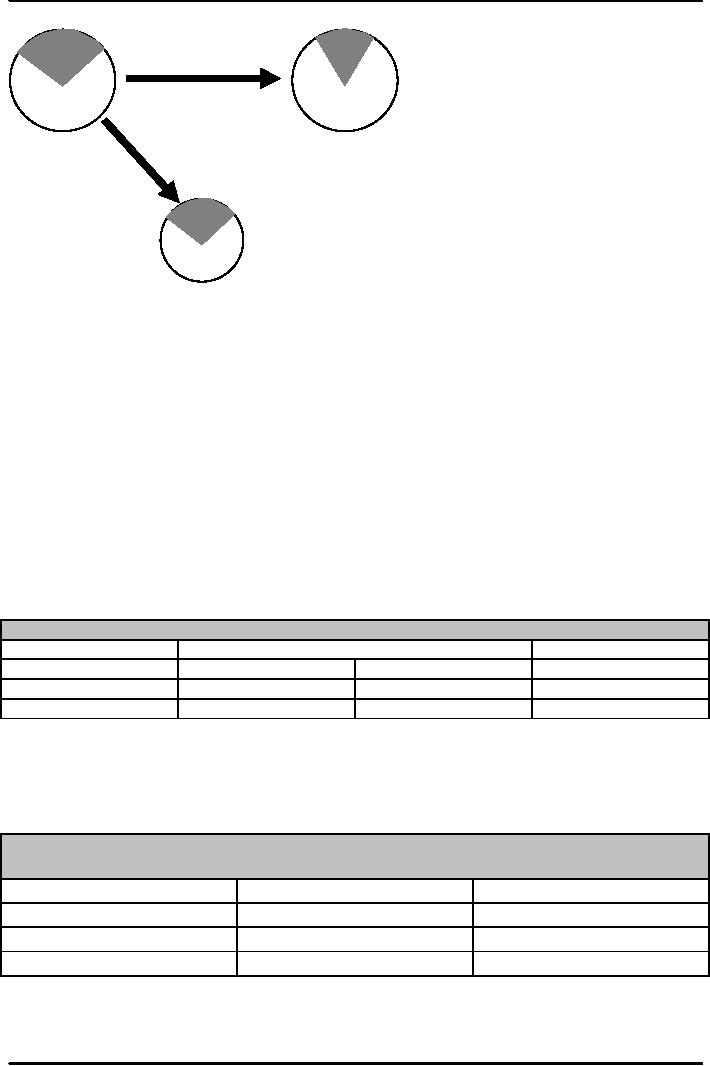 |

Money
& Banking MGT411
VU
Lesson
12
EVALUATING
RISK
Sources
of Risk
Idiosyncratic
Systematic
Reducing
Risk through
Diversification
Hedging
Risk
Spreading
Risk
Bond
and Bond Pricing
How
to Evaluate Risk
Lets
go back to our previous example where
$1,000 yields either $1,400
and $700 with equal
probability
If
we think about this
investment in terms of gains and
losses, this investment
offers an equal
chance
of gaining $400 or loosing
$300
Should
you take the risk?
Table:
Evaluating the Risk of a
$1,000 investment
A.
The Gain
Payoff
Probability
+
$400
�
$0
�
B.
The Loss
Payoff
Probabilities
$0
�
-
$300
�
Deciding
if a risk is worth
taking
List
all the possible outcomes or
payoffs
Assign
a probability to each possible
payoff
Divide
the payoffs into gains and
losses
Ask
how much you would be
willing to pay to receive the
gain
Ask
how much you would be
willing to pay to avoid the
loss
If
you are willing to pay more
to receive the gain than to
avoid the loss, you should
take the risk
Sources
of Risk
Risk
is everywhere. It comes in many
forms and from almost every
imaginable place
Regardless
of the source, risks can be classified as
either idiosyncratic or
systematic
Idiosyncratic,
or unique, risks affect only a
small number of
people.
Systematic
risks affect everyone.
In
the context of the entire
economy,
Higher
oil prices would be an
idiosyncratic risk and
Changes
in general economic conditions would be
systematic risk.
37

Money
& Banking MGT411
VU
ABC's
ABC's
Share
Share
Idiosyncratic
Risk
ABC's
share of
existing
market
shrinks
Systematic
Risk
ABC's
Share
Total
Automobile market
Reducing
Risk through Diversification
Risk
can be reduced through
diversification, the principle of holding
more than one risk at a
time.
Holding
several different investments reduces the
overall risk that an
investor bears
A
combination of risky investments is often
less risky than any
one individual
investment
There
are two ways to diversify
your investments:
You
can hedge risks or
You
can spread them among the many
investments
Hedging
Risk
Hedging
is the strategy of reducing overall risk
by making two investments with
opposing risks.
When
one does poorly, the other
does well, and vice
versa.
So
while the payoff from each
investment is volatile, together
their payoffs are
stable.
Table:
Payoffs on Two Separate Investments of
$100
Payoff
from Owning Only
Possibility
ABC
Electric
XYZ
Oil
Probability
Oil
price rises
$100
$120
1/2
Oil
price falls
$120
$100
1/2
Let's
compare three strategies for
investing $100, given the
relationships shown in the table:
Invest
$100 in ABC Electric
Invest
$100 in XYZ Oil
Invest
half in each company $50 in
ABC and $50 in XYZ
Table:
Results of Possible Investment
Strategies:
Hedging
Risk, Initial Investment =
$100
Investment
Strategy
Expected
Payoff
Standard
Deviation
ABC
Only
$110
$10
XYZ
Only
$110
$10
�
and �
$110
$0
38

Money
& Banking MGT411
VU
Spreading
Risk
Investments
don't always move
predictably in opposite directions, so
you can't always
reduce
risk
through hedging
You
can lower risk by simply
spreading it around and finding investments
whose payoffs are
completely
unrelated
The
more independent sources of risk
you hold the lower your
overall risk
Adding
more and more independent sources of risk
reduces the standard deviation
until it
becomes
negligible.
Consider
three investment strategies:
a.
ABC
Electric only,
b.
EFG
Soft only, and
c.
Half
in ABC and half in
EFG
The
expected payoff on each of these
strategies is the same:
$110.
For
the first two strategies,
$100 in either company, the
standard deviation is still
10, just as it
was
before.
But
for the third strategy, $50
in ABC and $50 in EFG, the
analysis is more complicated.
There
are four possible outcomes,
two for each stock
Table:
Payoffs from Investing $50 in
each of two
Stocks
Initial
Investment = $100
Possibilities
ABC
EFG
Soft
Total
Payoff
Probability
#1
$60
$60
$120
�
#2
$60
$50
$110
�
#3
$50
$60
$110
�
#4
$50
$50
$100
�
Table:
Results of Possible Investment
Strategies:
Spreading
Risk
Initial
Investment = $100
Investment
Strategy
Expected
Payoff
Standard
Deviation
ABC
$110
$10
EFG
Soft
$110
$10
�
and �
$110
$7.1
39
Table of Contents:
- TEXT AND REFERENCE MATERIAL & FIVE PARTS OF THE FINANCIAL SYSTEM
- FIVE CORE PRINCIPLES OF MONEY AND BANKING:Time has Value
- MONEY & THE PAYMENT SYSTEM:Distinctions among Money, Wealth, and Income
- OTHER FORMS OF PAYMENTS:Electronic Funds Transfer, E-money
- FINANCIAL INTERMEDIARIES:Indirect Finance, Financial and Economic Development
- FINANCIAL INSTRUMENTS & FINANCIAL MARKETS:Primarily Stores of Value
- FINANCIAL INSTITUTIONS:The structure of the financial industry
- TIME VALUE OF MONEY:Future Value, Present Value
- APPLICATION OF PRESENT VALUE CONCEPTS:Compound Annual Rates
- BOND PRICING & RISK:Valuing the Principal Payment, Risk
- MEASURING RISK:Variance, Standard Deviation, Value at Risk, Risk Aversion
- EVALUATING RISK:Deciding if a risk is worth taking, Sources of Risk
- BONDS & BONDS PRICING:Zero-Coupon Bonds, Fixed Payment Loans
- YIELD TO MATURIRY:Current Yield, Holding Period Returns
- SHIFTS IN EQUILIBRIUM IN THE BOND MARKET & RISK
- BONDS & SOURCES OF BOND RISK:Inflation Risk, Bond Ratings
- TAX EFFECT & TERM STRUCTURE OF INTEREST RATE:Expectations Hypothesis
- THE LIQUIDITY PREMIUM THEORY:Essential Characteristics of Common Stock
- VALUING STOCKS:Fundamental Value and the Dividend-Discount Model
- RISK AND VALUE OF STOCKS:The Theory of Efficient Markets
- ROLE OF FINANCIAL INTERMEDIARIES:Pooling Savings
- ROLE OF FINANCIAL INTERMEDIARIES (CONTINUED):Providing Liquidity
- BANKING:The Balance Sheet of Commercial Banks, Assets: Uses of Funds
- BALANCE SHEET OF COMMERCIAL BANKS:Bank Capital and Profitability
- BANK RISK:Liquidity Risk, Credit Risk, Interest-Rate Risk
- INTEREST RATE RISK:Trading Risk, Other Risks, The Globalization of Banking
- NON- DEPOSITORY INSTITUTIONS:Insurance Companies, Securities Firms
- SECURITIES FIRMS (Continued):Finance Companies, Banking Crisis
- THE GOVERNMENT SAFETY NET:Supervision and Examination
- THE GOVERNMENT'S BANK:The Bankers' Bank, Low, Stable Inflation
- LOW, STABLE INFLATION:High, Stable Real Growth
- MEETING THE CHALLENGE: CREATING A SUCCESSFUL CENTRAL BANK
- THE MONETARY BASE:Changing the Size and Composition of the Balance Sheet
- DEPOSIT CREATION IN A SINGLE BANK:Types of Reserves
- MONEY MULTIPLIER:The Quantity of Money (M) Depends on
- TARGET FEDERAL FUNDS RATE AND OPEN MARKET OPERATION
- WHY DO WE CARE ABOUT MONETARY AGGREGATES?The Facts about Velocity
- THE FACTS ABOUT VELOCITY:Money Growth + Velocity Growth = Inflation + Real Growth
- THE PORTFOLIO DEMAND FOR MONEY:Output and Inflation in the Long Run
- MONEY GROWTH, INFLATION, AND AGGREGATE DEMAND
- DERIVING THE MONETARY POLICY REACTION CURVE
- THE AGGREGATE DEMAND CURVE:Shifting the Aggregate Demand Curve
- THE AGGREGATE SUPPLY CURVE:Inflation Shocks
- EQUILIBRIUM AND THE DETERMINATION OF OUTPUT AND INFLATION
- SHIFTS IN POTENTIAL OUTPUT AND REAL BUSINESS CYCLE THEORY